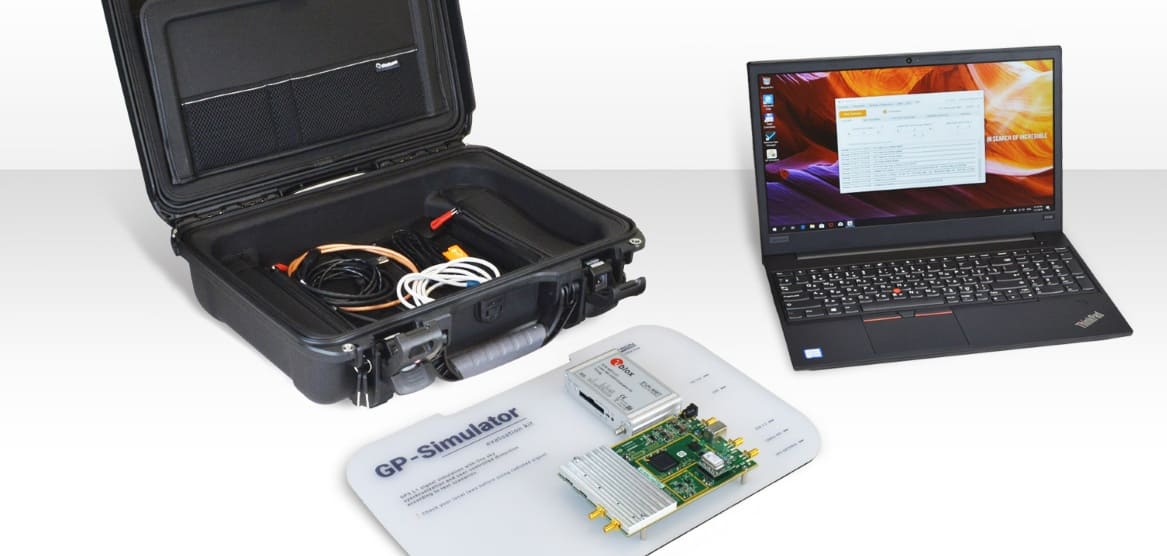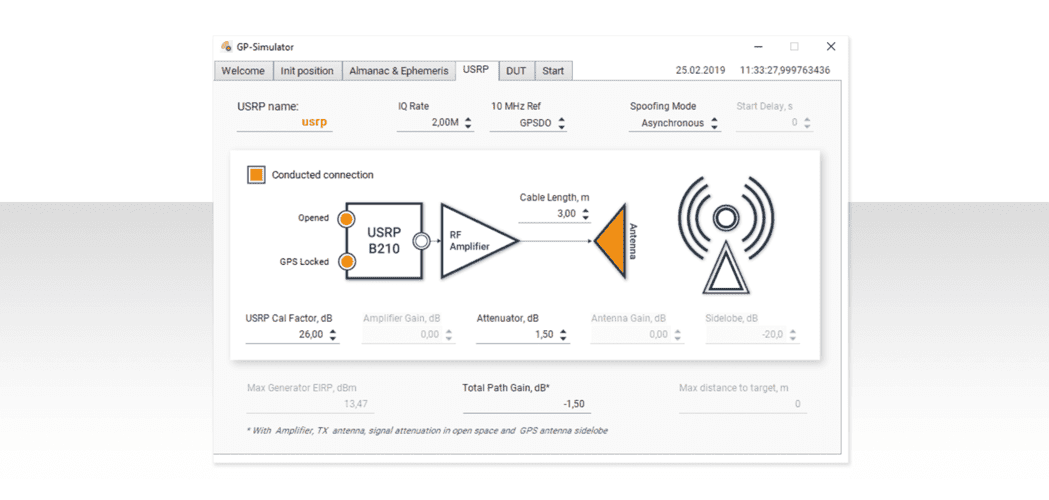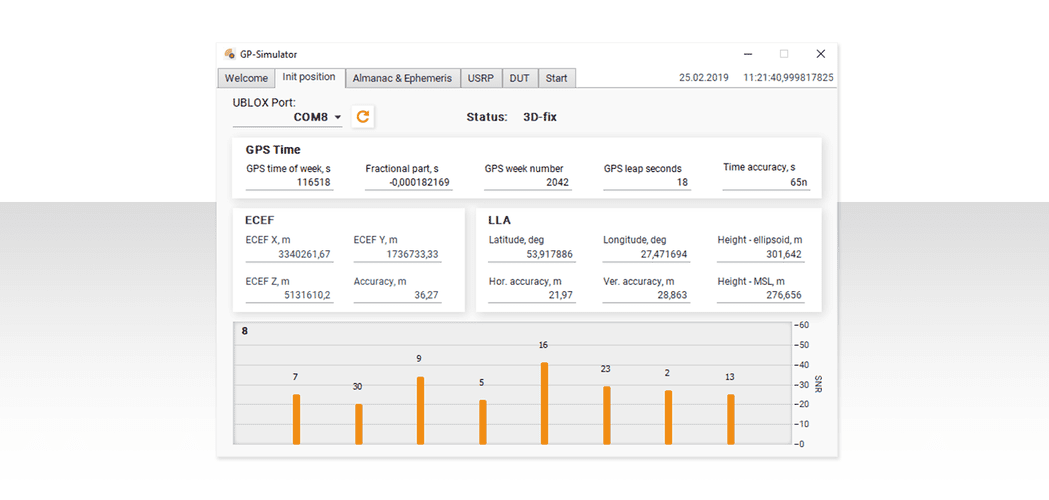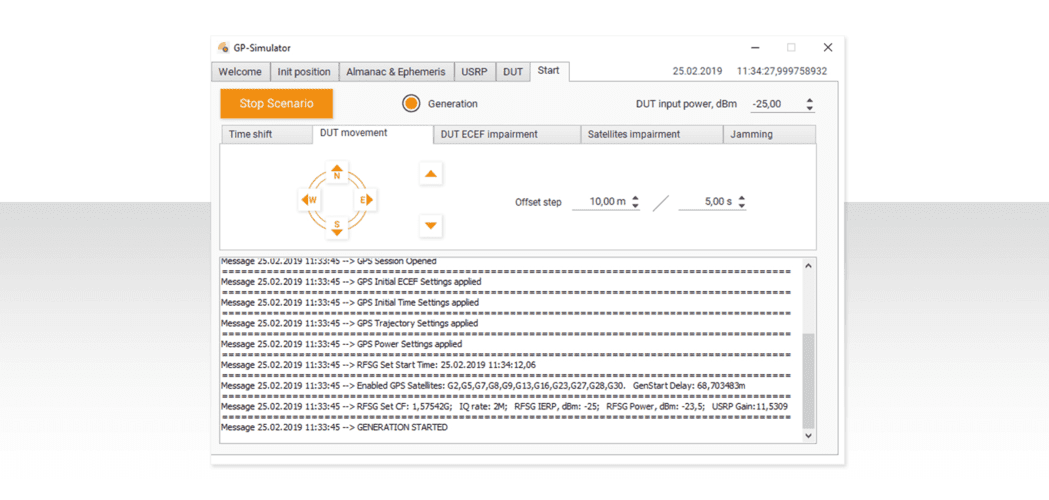DISCONTINUED
GP-Simulator
SDR-Based GPS Simulator for Spoofing Vulnerability Testing
Easy-to-use solution not requiring advanced GNSS knowledge. Supports live sky and over-the-air spoofing
Key Features
We developed this application to research various GNSS spoofing scenarios and to test techniques for detecting deliberate precision attacks. The simulator enables live over-the-air operations and flexible manipulation of coordinates and timing. It is a perfect solution for cybersecurity experts to test time servers, drones, and self-driving vehicles.
Live Sky Spoofing
Real-world spoofing attacks would not take place under lab conditions! GP-Simulator enables testing in realistic live sky environment.
Over-the-Air Testing
The app makes it easy to configure the signal transmission over the air. It takes into account the parameters of TX/RX antennas, RF amplifiers, cables and the distance to the device under test. Great option for drone testing.
Coherent Spoofing Scenario
At the first step of synchronous (coherent) spoofing, the fake signal is completely identical to the real one. The attacked receiver immediately switches to the fake signal without loss of tracking.
Time or Coordinates Manipulation
The application enables real-time manipulation of timestamp, PPS phase, coordinates, and individual satellite parameters. Distortions can be applied to simulate the behavior of real signals.
True Almanac and Ephemeris
GP-Simulator utilizes genuine almanac and ephemeris files from NASA websites. This ensures a successful attack on a receiver with basic spoofing protection algorithms.
Easy-to-Use Solution
The solution is designed for cybersecurity specialists without relevant GNSS knowledge. GPSPATRON team provides online training on testing the vulnerability of GNSS receivers, time servers, drones, RTK base stations.
Specification
Required Hardware
- Ettus Research USRP Bus Series with GPSDO;
- Ublox M8T GNSS receiver for live sky synchronization;
- Computer with USB 3.0 port and Internet connection;
- Optional external 10 MHz reference source (for over-the-air test).
Supported Operating Systems
- Windows 10 (32-bit and 64-bit);
- Windows 8 (32-bit and 64-bit);
- Windows 7 SP1 (32-bit and 64-bit).
Minimum System Requirements
- Intel® Core™ i3 Processors;
- RAM 8 GB;
- Free hard drive space 1-GB;
- One port USB 3.0;
- Two ports USB 2.0;
- Internet.
Supported GNSS
GPS L1 C/A, 12 satellites
GPS spoofing simulation modes
- Asynchronous (non-coherent);
- Synchronous (coherent).
Live sky synchronization with
Live sky synchronization time accuracy
± 250 ns to UTC RMS (2-Sigma)
GPSDO 10 MHz Accuracy
1 ppb
Maximum USRP Output Power, RMS
15 dBm
Minimum USRP Output Power, RMS
-65 dBm
Output Power Regulation Step
0,5 dB
Almanac source
Ephemeris source
GPS signal impairments
- 1PPS shift;
- ToW shift;
- LLA shift;
- DUT ECEF noise and offset;
- Satellites power, pseudorange, Doppler offset;
- Jamming simulation.
The installation package contains
- NI Labview Run-Time Engine 2018 f1
- NI GNSS Simulation Toolkit 3.0
- Python 3.7.2
- Patrotest Application Manager
- 7-zip
- UHD driver for USRP
- drivers for UBLOX & USB-RS232 converter
Accessories
GP-Simulator Evaluation Kit
- Lenovo ThinkPad with the preinstalled software;
- Ettus Research USRP B200 with GPSDO and additional RF shielding;
- Directional coupler, set of RF attenuators, cables, and adapters for conducted tests;
- Ublox M8T GNSS receiver for live sky synchronization with a USB cable and USBRS-232 adapter;
- All equipment is mounted on a plastic panel;
- The Evaluation Kit comes in the NANUK 923 protective case.
How-to Spoof Video Guides
Required hardware and connection diagrams. App configuration. Synchronous and asynchronous attack techniques. Position spoofing. Time manipulation. Vulnerability testing of GNSS receivers, time servers, drones, RTK stations, and much more can be found on our YouTube Channel








